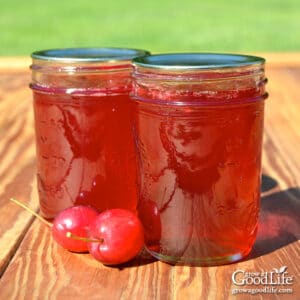
Homemade Crabapple Jelly with No Added Pectin
Transform the tart flavor of crabapples into a delicious homemade crabapple jelly. Crabapples have enough natural pectin so no additional pectin is needed for this crabapple jelly recipe.
Instructions
Extract the Juice:
- Wash the crabapples well in plain water, remove the stems, cut out any bad spots, and trim the blossom ends. Cut the crabapples in half. Use a kitchen scale to weigh out 3 pounds.
- Extract the juice by combining the prepared crabapples in a large saucepan with enough water so that the fruit is barely covered, about 3 cups.
- Bring to a boil over medium-high heat, then reduce to a simmer, and cook the crabapples. Heat and simmer slowly until skins have softened, and the juices are released.
- Gently mash the crabapples with a potato masher and simmer over low heat for about 20 minutes, stirring occasionally. Do not overcook crabapples because excess heat will destroy the pectin and change the flavor and color.
- Strain the cooked fruit through a damp jelly bag or double layers of cheesecloth. Allow the crabapples to strain for at least 2 hours or overnight in the refrigerator.
- If you want clear jelly, do not squeeze the bag. I care more for flavor rather than appearance, so I often give the bag a squeeze to press out all the flavorful juice. Discard solids.
Prepare the Canning Equipment
- Wash your jars, lids, screw bands, and canning tools in hot soapy water. Rinse thoroughly to remove all suds. Set aside to air dry on a clean kitchen towel.
- Place the jar rack into water bath canner, place jars in the canner, and add water to cover.
- Bring the canner to a simmer (180˚F) for 10 minutes, and keep the jars hot until you are ready to fill them.
Make the Jelly
- Measure 4 cups of crabapple juice and pour it into a saucepan, add the sugar and stir to dissolve. Bring to a boil over medium-high heat, stirring constantly, until jelly stage.
- Jelly stage is achieved once the temperature reaches 220˚F at altitudes of less than 1,000 feet (see notes for altitude adjustments), when the liquid forms a sheet that hangs off the edge of the spoon, and when the mixture gels on a cool plate and doesn't run when tipped.
Can the Jelly
- Lay a kitchen towel on the counter. Use the jar lifter to remove a jar from the canner, drain the water back into the canner, and place it on the towel. Keep the remaining jars in the canner so they stay hot.
- Use your canning ladle and funnel and add the hot jelly to the warm jar leaving 1/4-inch headspace. Swirl your bubble popper through to release air bubbles, and wipe the rim of the jar with a damp towel to remove any sticky residue.
- Center a lid on the jar, and screw on the band until it is fingertip tight. Use the jar lifter to place the jar back into the canner, and repeat with the remaining jars. Try to leave some space in between the jars.
- Once all the jars are in canner, adjust the water level to two inches above the jar tops.
- Cover the canner and bring to boil over high heat. Once the water boils vigorously, continue boiling for 10 minutes at altitudes of less than 6,000 ft. (adjust processing time for your altitude if necessary – see notes below).
- When processing time is complete, turn off heat and allow the canner to cool down and settle for about 5 minutes.
- Spread a dry kitchen towel on the counter. Remove the cover by tilting lid away from you so that steam does not burn your face.
- Use the jar lifter to lift jars carefully from canner and place on the towel. Keep the jars upright, and don't tighten bands or check the seals yet. Let the jars sit undisturbed for 12 to 24-hours to cool.
- After the jars have cooled for at least 12 hours, check to be sure jar lids have sealed by pushing on the center of the lid. The lid should not pop up. If the lid flexes up and down, it did not seal. Refrigerate the jar and use up within a few weeks.
- Remove the screw on bands and wash the jars. Label and date the jars. Store your jars in a cool, dark place and use within 12 to 18 months. Yields about 4 to 6 half-pint jars depending on the natural pectin level in your crabapples. Refrigerate the jelly once opened and consume within 2 weeks.
Notes
This is a tested safe canning recipe from the USDA Complete Guide to Home Canning and the Ball Blue Book Guide to Preserving. Altering the recipe may make it unsafe for canning.
All times are at altitudes of less than 1,000 ft. Adjustments must be made for altitudes greater than 1,000 ft:
- Temperature Test: Adjustments for altitude: 1,000 feet = 218˚F, 2,000 feet = 216˚F, 3,000 feet = 214˚F, 4,000 feet = 212˚F, 5,000 feet = 211˚F, 6,000 feet = 209˚F, 7,000 feet = 207˚F, 8,000 feet = 205˚F,
- Processing Time: Adjustments for altitude: 6,001 – 8,000 feet = 15 minutes, above 8,001 feet = 20 minutes.
Nutrition
Serving: 1tablespoonCalories: 50kcal
Tried this recipe?Let us know how it was!